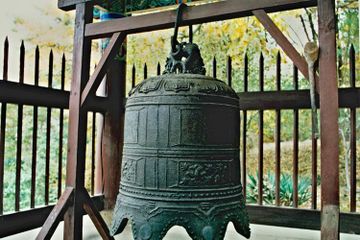밀양 백운사 범종
| 밀양 백운사 범종 Buddhist Bell of Baegunsa Temple, Miryang |
|
 밀양 백운사 범종, 국가문화유산포털, 문화재청. |
|
| 대표명칭 | 밀양 백운사 범종 |
|---|---|
| 영문명칭 | Buddhist Bell of Baegunsa Temple, Miryang |
| 한자 | 密陽 白雲寺 梵鐘 |
| 주소 | 경상남도 밀양시 추화산성길 119-17 (교동) |
| 지정번호 | 경상남도 유형문화재 제57호 |
| 지정일 | 1972년 2월 12일 |
| 분류 | 유물/불교공예/의식법구/의식법구 |
| 수량/면적 | 1구 |
| 웹사이트 | 밀양 백운사 범종, 국가문화유산포털, 문화재청. |
해설문
국문
중국 원나라의 영향을 받아 만들어진 종으로 높이 85㎝, 몸통 둘레 180cm, 입 지름 65㎝이다. 추화산(推火山) 중턱 영천암(靈泉庵) 경내에 있다. 전체적인 생김새와 문양이 한국 종의 일반적인 모습과 다르다.
종을 매다는 용뉴에는 두 마리의 용이 얽힌 모습을 하고 있고, 아래 가장자리는 반원 여덟 개를 이어붙인 듯한 물결 모양을 이루고 있다. 몸통 부분은 위아래로 선을 그어 4개 구획을 만들었다. 우리나라 범종에서 흔히 볼 수 있는 비천문(飛天紋) 대신 아(亞)자 문양과 팔괘(八卦) 무늬가 조각되어 있고, 위에는 종소리를 맑으면서 울림을 길게 해주는 음통 대신 구멍이 나 있다. 중국 원나라 범종에 나타나는 양식으로 우리나라에서는 조선 후기에 일부 나타났다.
종 하단에는 종을 헌납한 시주자 이름이 적혀 있지만 조성 연유나 주조 연대는 판독되지 않았다. 이 종은 1945년 광복 직후 부산 영도의 고철 야적장에서 발견했다고 한다.
영문
Bronze Bell of Baegunsa Temple, Miryang
A Buddhist bell is traditionally used to gather people for rituals and announce the time at a temple. This bell is said to have been discovered in 1945 at a scrap metal yard in Busan and moved to the current location. It is unknown when or where the bell was originally made, but its overall form and decorative elements, which differ significantly from typical Korean bells, appear to be influenced by the style of Yuan China (1271-1368).
The bell measures 85 cm in height, 180 cm in circumference, and 65 cm in diameter at the mouth. The cannon by which the bell is hung is shaped like a pair of conjoined dragons, and four holes were created at the bell’s shoulder to increase its resonance. The bell’s body is visually divided into four horizontal sections using linear designs and features decorative elements such as Chinese character patterns (亞) and the Eight Trigrams. The bell’s lip is shaped like a wave. Such features are typical of bells from Yuan China, but can also be found on some Korean bells cast in the late period of the Joseon dynasty (1392-1910). The bell also features an inscription that lists the names of the patrons who supported the bell’s casting.
영문 해설 내용
범종은 사찰에서 의식을 행할 때 사람들을 모으거나 시각을 알릴 때 사용한다. 이 종은 1945년 부산의 어느 고철 야적장에서 발견되어 이곳으로 옮겨졌다고 한다. 언제 어디서 만들어졌는지는 알 수 없으며, 전체적인 생김새와 문양이 한국 전통 종의 일반적인 특징과 달라 중국 원나라 종 양식의 영향을 받아 만들어진 것으로 보인다.
이 종은 높이 85㎝, 몸통 둘레 180cm, 입 지름 65㎝이다.
종의 꼭대기에는 종을 매달기 위한 고리인 용뉴가 두 마리 용이 얽힌 모습으로 만들어져 있고, 어깨 부분에는 종소리를 길게 울리도록 하기 위해 4개의 구멍을 뚫었다. 몸통에는 선을 그어 4개의 구획을 만들었고, 아(亞)자 문양과 팔괘(八卦) 무늬를 조각했다. 종의 아랫부분 가장자리는 물결 모양을 이루고 있다. 이러한 특징들은 원나라 종의 일반적인 양식으로 조선 후기에 만들어진 종에서 일부 나타난다. 이 종에는 또한 이 종을 헌납한 시주자 수십 명의 이름이 나열된 명문이 있다.
- 현재 국가문화유산 포털에 지정명칭이 '동종'으로 되어 있는데, '범종'으로 수정할 예정임.
- 문화재 명칭은 '백운사 동종'인데 현재 있는 곳은 영천암임. 백운사와 영천암이 어떤 관계인지 확인되지 않고, 왜 '백운사 동종'인지도 확인되지 않음.
참고자료
- “백운사 범종(白雲寺 梵鐘)”, 밀양 문화관광. http://www.miryang.go.kr/tur/index.do?mnNo=30302010000
- 백운사 범종, 두피디아 포토커뮤니티. https://www.doopedia.co.kr/photobox/comm/community.do?_method=view&GAL_IDX=101227000773514#hedaer